Physical Address
304 North Cardinal St.
Dorchester Center, MA 02124
Physical Address
304 North Cardinal St.
Dorchester Center, MA 02124
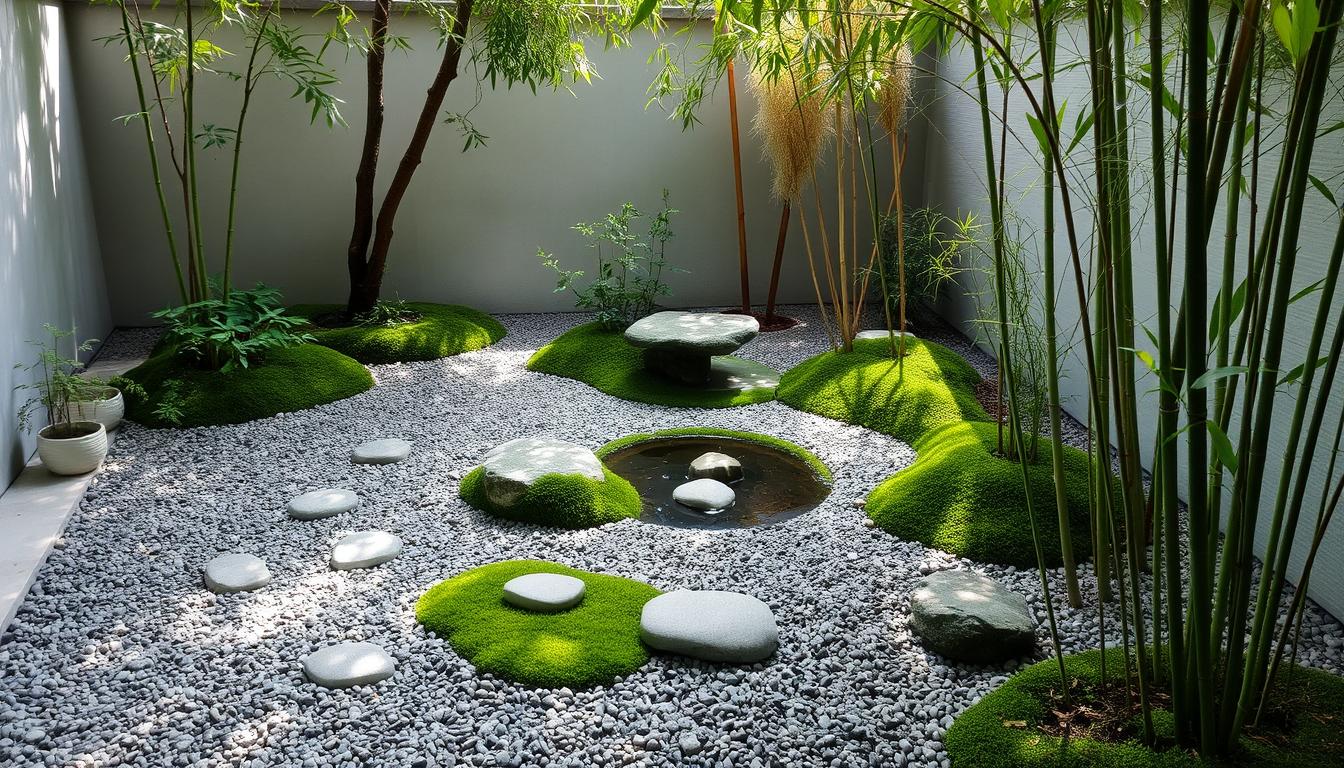
In today’s fast-paced world, we often seek quiet spots that calm our minds. Creating Zen gardens for small areas answers this call, turning tight spaces into peaceful retreats. Imagine making a tiny patio or a forgotten corner into your personal haven.
Zen gardens attract us with their calm beauty and thoughtful layout. They skillfully mix elements like rocks, sand, and water features. Even in limited areas, these gardens offer a peaceful escape for rest and thought. No matter if you live in a lively urban flat or a snug house, these Zen Garden Small Spaces ideas will make your outdoor space a peaceful sanctuary.
We dive into Japanese Gardens Design Ideas with advice from landscape experts like Melissa Reavis of Hollander Design. From the soothing sound of gravel underfoot to the glitter of flowing water, starting a Compact Zen Garden is about making wise choices and designing with intent.
This journey also includes insights from designers like Patricia Benner and Molly Wood. They point out key elements for Zen gardens. Be it meaningful rocks, vibrant plants, or gentle water features, each piece aims to create calm and harmony. Small gardens show us how minimalism and nature can turn tight spots into broad, reflective landscapes.
Gravel paths make serene walkways in a Zen garden simple to create. They offer a way to move around that looks good and feels peaceful. Such paths fit perfectly with the style of a Modern Zen Garden. They add to the calming effect of each step in your garden.
The sound of gravel crunching underfoot turns walking in your garden into a meditative act. This sound is a key feature of traditional Japanese gardens. It helps focus the mind. By adding gravel, each step becomes a moment for peace and thought. This makes your garden both beautiful and functional, fitting well with impactful Garden Landscaping Design Ideas.
Raking gravel into beautiful patterns can make your garden look special. These patterns, which mimic water and waves, have been used for centuries. They make your garden a place for reflection. Adding them to your Modern Zen Garden is about both the look and the experience of raking. This act is calming, making your garden a true retreat.
Turning a small space into a serene oasis is very rewarding. To make a Small Space Landscaping work, you need the right elements. It can be a Miniature Meditation Garden or a traditional Japanese Style Garden. Your journey starts with careful selection and layout.
Choosing the right plants is key for a balanced, calming space. You can use bonsai trees, dwarf conifers, or lush mosses. These fit well in small areas. They follow minimalism and bring a green touch to your garden. Did you know all kids love making a mini Zen garden for calmness? This shows the peace these gardens give.
A Japanese Style Garden needs minimalistic design. Adding small stone lanterns, a Buddha statue, or decorative rocks can bring peace. The simplicity and beauty of these items create a space for meditation and relaxation. Mindfulness here can boost focus by 70%. It’s a perfect peaceful spot at home.
Using minimalistic items and choosing plants carefully is crucial. They make up 65% of the design process. This makes your Miniature Meditation Garden a simple, serene break from daily life.
Adding water features to your Small Japanese Garden Ideas can truly enhance its calm and beauty. Even in small gardens, water’s gentle sounds and looks bring deep peace and mindfulness. Let’s look at some Small Japanese Garden Ideas for including water creatively.
Trickling fountains are an easy option for your garden. They’re great for both an *Indoor Japanese Garden* and outdoors. They come in designs from simple ones for your table to elaborate freestanding ones. The flowing water sounds can help you feel calm, like you’re near a natural stream.
You can find trickling fountains in many finishes, like Rodda Bronze and Verde. They fit well with your Zen Garden Design and last a long time. Their look and durability make them perfect for peaceful spaces.
Koi ponds add vibrant spots to small Zen gardens. They give a home to colorful koi fish, adding movement and life. Even in small gardens, today’s designs allow ponds that are easy to care for.
You can build these koi ponds with durable materials in different shapes and sizes. Adding things like a bamboo kakei or stone basins adds beauty and tradition. They can have several levels, making waterfalls that enhance your garden’s mood.
Choosing a koi pond means you can pick finishes and styles that boost your *Zen Garden Design*. Picture the beautiful mix of water, light, and nature, making your small garden a peaceful sanctuary.
Adding water features to your Indoor Japanese Garden or outside area brings a dynamic touch that changes the feel. The sound from a fountain or the calm from a koi pond can make any small garden a serene retreat.
Bamboo is a top choice for Bamboo Garden Designs because of its looks and usefulness. It adds privacy and a peaceful charm to Asian Garden Backyards. It is also key for those creating Small Zen Garden Ideas.
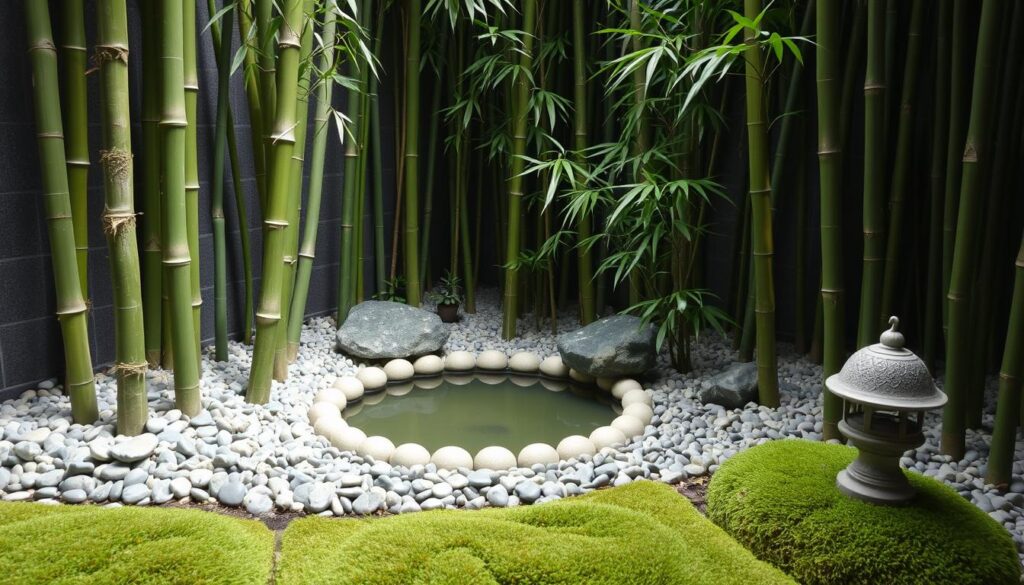
Bamboo screens and fences offer privacy with a beautiful touch. They act as natural barriers that fit right into your garden. To install them properly, use the Bamboo Shield. This keeps the bamboo in certain garden areas, keeping your design intact and stopping unwanted spreading.
Bamboo isn’t just for fences; it’s also great for calming water features. The sound of water flowing from bamboo brings peace, perfect for Small Zen Garden Ideas. Try a Shishi-odoshi, a bamboo fountain that scares pests and soothes with its sound.
“Being in tea gardens, with a lot of bamboo, helps relax you. It can make you calmer and lower your heart rate.”
Adding bamboo to your Asian Garden Backyard makes it more beautiful and peaceful. Let’s make our small spaces into places of calm, using these old garden design ideas.
Adding a Japanese Maple to your Zen garden boosts its beauty and calmness. Their elegant form and bright colors change with seasons. The Crimson Queen and compact types fit well in small areas. They keep the garden lively all year.
Dwarf Japanese Maples are best for small gardens. Varieties like ‘Shaina’ and ‘Sharp’s Pygmy’ grow just right in tight spaces. These can even thrive in pots, ideal for Oak House patios or balconies. They easily blend into your Zen space.
Japanese Maples change colors with the seasons. Their vibrant hues make them standout features in your garden. When placed well, they draw attention and improve your garden’s look.
Their detailed leaves and shape bring balance to your garden. They mirror the deep-rooted traditions of Zen gardens with Japanese Maples.
Adding Zen Garden Lighting to your peaceful patio gardens can make them true havens for night-time calm. The key is to place soft, ambient lights thoughtfully. Night serenity is more than seeing; it’s making a Zen atmospheric lighting mood that highlights special areas, improves usability, and boosts both looks and function.
Think about combining ground lights for paths and taller lights for key spots like sculptures or water features. This mix of lighting types adds depth and texture. It makes your serene patio gardens seem larger and more welcoming as evening falls.
By carefully adding these elements, your garden shines not just by day but also by night. Zen garden lighting brings out the peace of your outdoor area, creating a calm spot for relaxation and thought.
The smart use of Zen atmospheric lighting combines practicality with beauty, making your garden a place of peace and unity, especially at night.
Rock gardens are a brilliant way to add texture and depth to your Zen garden. They mix natural elements together to bring peace and harmony. You can fit rock gardens into any size space, bringing serenity to sprawling Japanese landscapes or cozy corners.
Finding the right rocks is key for true Rock Garden Designs. Each rock, from smooth pebbles to large boulders, adds its own story. A raised garden might work best for those wanting a stunning, yet contained feature. Plants like succulents, alongside warm-colored rocks in desert themes, look amazing.
In Japanese gardens, rocks represent more than just beauty. They stand for mountains, islands, or animals, making every stone’s placement important. These stones add depth and tell a story, making your garden unique. Terrace designs or boulders work wonders in hillside gardens, making the most of the space.
Use a layering method to mix plants and rocks in your garden. Group similar plants and arrange them around the rocks beautifully. Scotch moss, daffodils, and hens and chicks are great for smaller gardens. They bring beauty and are easy to care for.
Aiming for a vast Japanese landscape or a simple spot, rock gardens add balance and beauty. The art and thought put into Rock Garden Designs make them special. They offer a visual treat and a peaceful spot for rest and meditation.
Floating deck designs are changing how we enjoy Zen gardens. These platforms create perfect spaces for calm and focus. Let’s look at turning these areas into tranquility centers.

Floating decks are super flexible. You can put them anywhere in your garden. They look great among colorful flowers or near a peaceful rock garden. They come in many stylish designs that are simple yet beautiful.
They also make cozy spots for meditation. With things like trellises or bamboo fences, you can make private retreats. These areas encourage quiet and deep thoughts.
Floating decks are key for Zen yoga areas. Choose materials that feel nice to walk on, like smooth wood. Adding peaceful items like water features or Buddha statues makes the space special.
These decks give you a firm place for yoga. The quiet of nature and smart design help with focus and mindfulness.
Whether for yoga or meditation, floating decks turn gardens into peaceful havens. They bring calm and balance to your outdoor space. Use them to make your garden a place of peace and harmony.
Having traditional Buddha statues in your garden does more than look pretty. They bring a feeling of peace and a spiritual vibe. These pieces act as Spiritual Garden Accents that encourage calmness and awareness. With careful placement, a Buddha statue can turn into the heart of your Zen Garden Design. It leads you towards feeling more relaxed and enlightened.
Here are some important tips for adding Buddha statues to your garden:
Buddha statues are not just for decoration; they stand for deep calm and a journey to better self-awareness. Mixing these sculptures with other Spiritual Garden Accents and natural bits like pebbles and rocks turns your garden into a place for meditation.
Zen Garden Lanterns are key to making your zen garden warm and welcoming. They light up paths and important spots softly.
Outdoor Zen Space Lighting comes in many lantern styles:
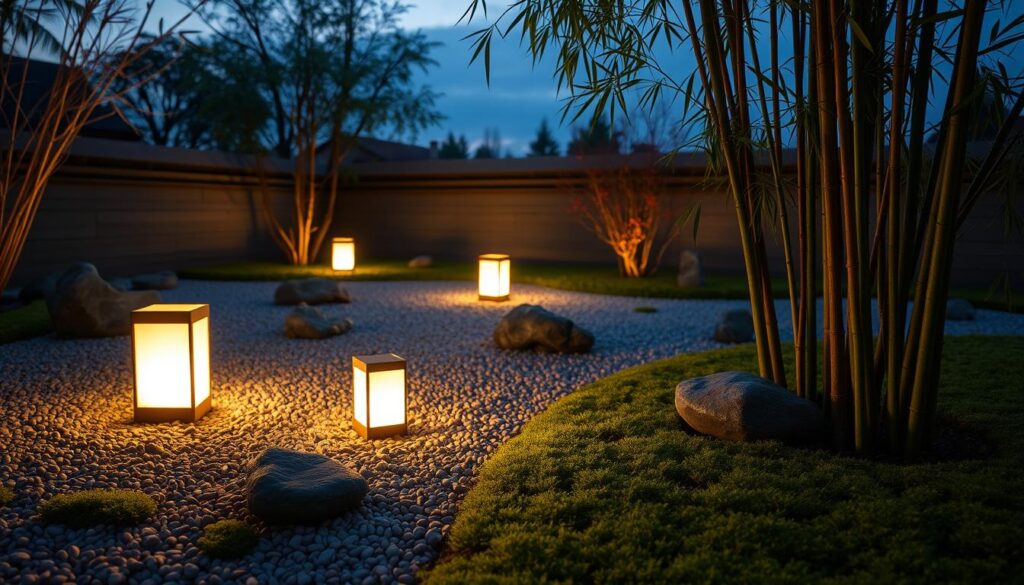
For the best effect with your Zen Garden Lanterns, try these placement ideas:
Zen Garden Pathways help guide and direct the flow of energy. They make different areas for varied experiences. These separated zones increase interaction within your Zen space.
Design your pathways with gentle curves for more beauty. These curves make you walk slower and enjoy every step. They also add visual interest and reveal new parts of your garden slowly.
The materials you choose affect your Zen Garden Pathways’ look and use. Here are ideas to inspire your next project:
Using these ideas can create separate zones and add to your Zen garden’s beauty. Each pathway’s material and design bring harmony and calmness to your space.
Moss is key for a peaceful Zen garden. Its softness and green color bring calm. Fern moss, cushion moss, and others help achieve this look.
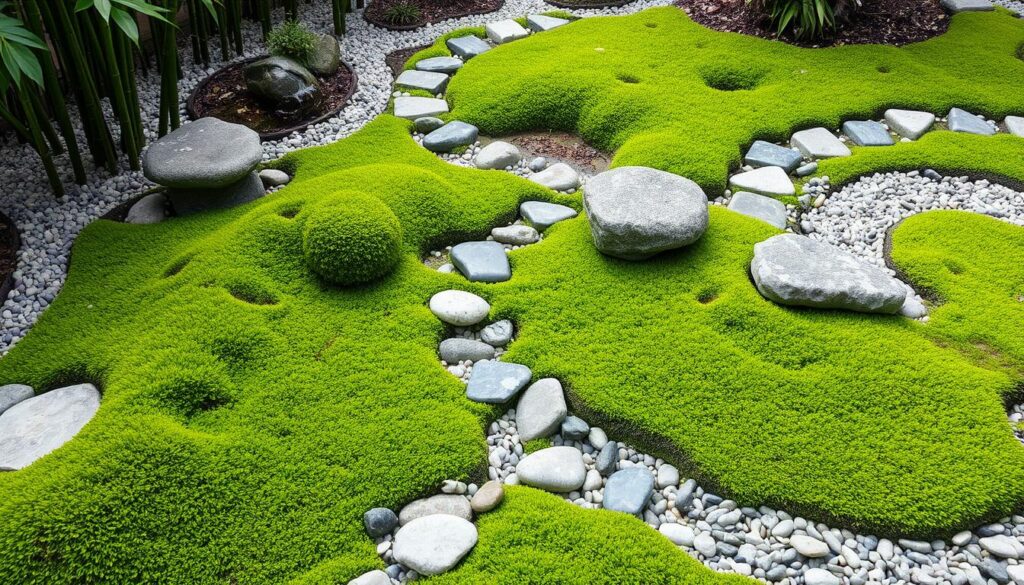
Moss makes Zen gardens feel alive and green. It works with rocks and water for a natural scene. Different moss types each add something special:
Moss like hair cap moss fills lawn gaps and hides tree stumps. These plants are easy to care for, thriving in shade.
Moss enhances a Zen garden’s look and helps the environment. It purifies air and water, reducing the carbon footprint. Mosses clean pollutants, creating a healthier space.
Adding moss to Zen gardens follows Zen simplicity. Kohei Owatari believes in using moss for serene spaces. Let moss bring peace to your garden.
When making a Low-Maintenance Zen Retreat, choosing the right ground cover is key. These plants add beauty and create a serene vibe with little work. Let’s look at some options that can make your garden an Eco-Friendly Garden Cover.
For your Zen garden, pick ground cover plants that love your local weather. They should also look right in your garden. Here are some great choices:
Looking after your ground cover plants should keep your Zen garden peaceful. Here’s how to care for them:
Adding these plants to your garden will make it more beautiful. It also creates a design that fits with Zen and Eco-Friendly principles.
To create a peaceful Patio Zen Garden, start with a smart landscaping plan. Choose low-maintenance evergreens like dwarf pine, bonsai, or ornamental grasses. These plants are key for achieving that Zen look. To brighten things up, add a flowering shrub. It will give a pop of color against the green.
Using vertical gardens is great for a Contemporary Zen Design. They make use of upward space and can liven up blank walls. A gentle water feature, like a small fountain, adds calming sounds. It makes your Patio Zen Garden feel more tranquil.
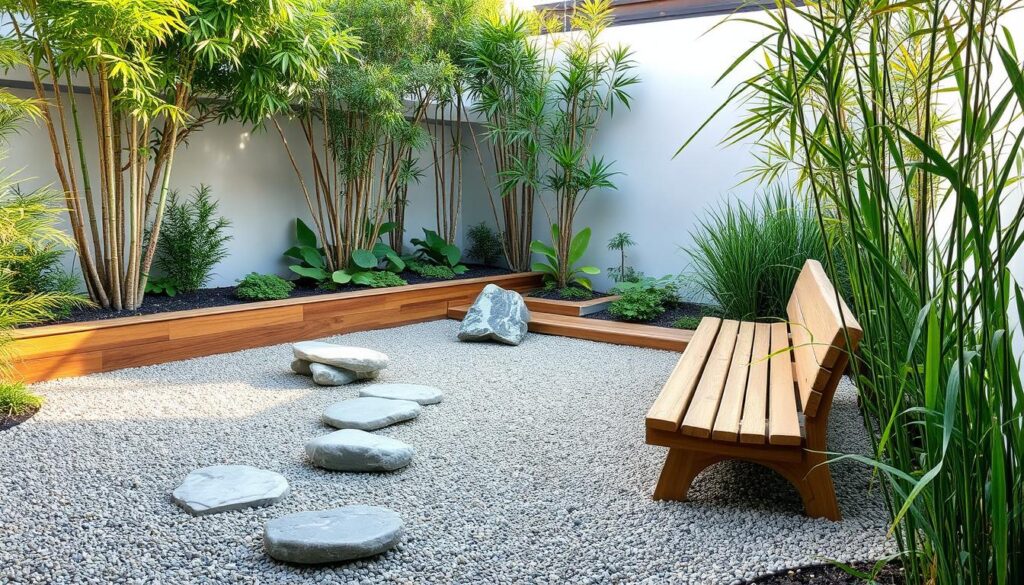
Lights set the mood in the evening. Solar-powered lights are perfect because they’re easy to install and green. Don’t forget about seating. It’s key for enjoying your peaceful garden. Choose cozy options like wooden benches or soft cushions.
It’s nice to add personal touches too. Things like wind chimes, art, or a birdbath make it feel like your own. With these elements, your Contemporary Zen Design becomes a space for relaxation and nature connection.
Adopting the ’20 Zen Garden Small Spaces’ idea means planning your garden carefully. We use every part of the garden wisely to turn tiny areas into peaceful retreats. We pick every plant and path to add quiet beauty without too much going on.
To nail a zen garden look, we think about using every bit of space. In small gardens, we often go vertical with things like trellises or hanging plants. This approach makes the garden seem bigger.
By doing this, we make sure every inch is both useful and looks great.
Thinking about what each part of the garden does is key. Everything from the paths to the plants should make the garden more peaceful and pretty. It’s all about adding things that make you feel calm and making sure they fit right into your small Zen space.
Incorporating traditional Japanese landscaping into your garden can transform your small space into a Japanese Zen Garden oasis. A key feature of Japanese garden design is the meticulous balance of elements. This includes stone placements, curated plant selections, and subtle water features. These details not only enhance the beauty but also bring spiritual harmony to your garden.
Using elements of Japanese design, like bamboo and moss, creates a serene environment. Bamboo, one of the fastest-growing plants, serves as both an ornamental plant and a structural component. It can become screens, fences, or natural water features, offering privacy and tranquility. Moss, on the other hand, works well in moist and shady areas. It adds a lush, green touch that is calming and visually appealing.
Water features are a key part of Japanese gardens. Whether it’s a small pond with goldfish or a trickling stone basin for cleansing, these features add soothing sounds and reflections. Koi ponds add a sense of continuity, as koi can live very long. Even a dry streambed made with gray river rocks can mimic water flow, fostering contemplative thought.
Personal touches make a Japanese Zen Garden authentic. Choose stones with specific meanings and introduce low-maintenance plants like Japanese maples. Place traditional lanterns to light up paths. Stepping stones and gravel paths guide visitors and encourage mindfulness through their deliberate placement. Every element, from the plants to the stones, connects to nature. This contributes to a harmonious garden experience, inviting peace and introspection.